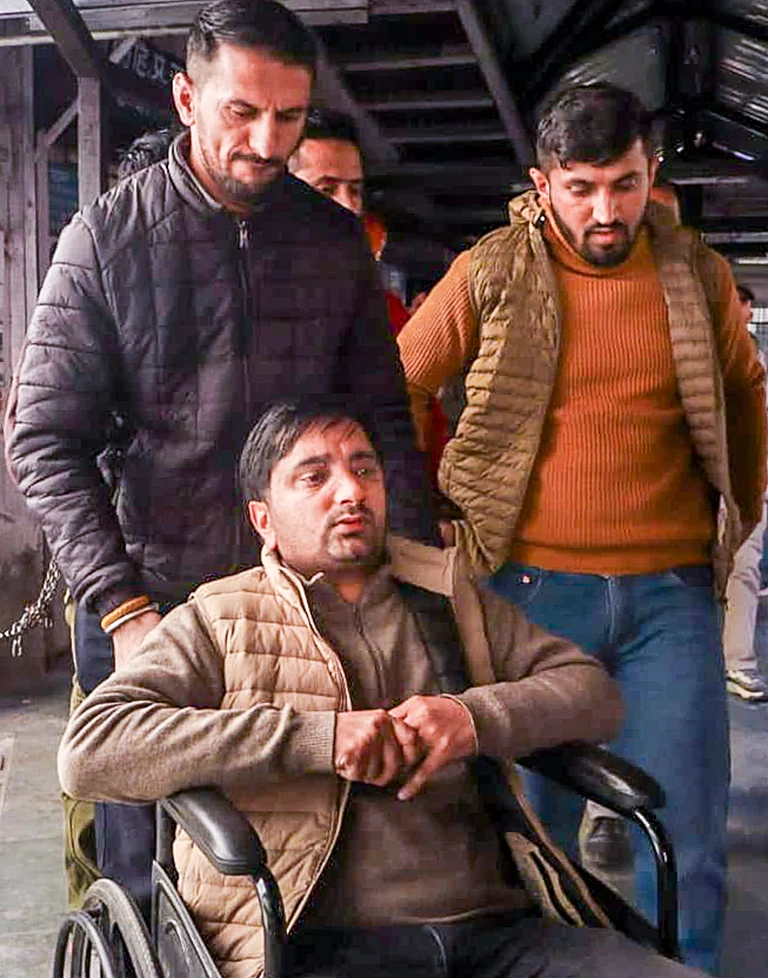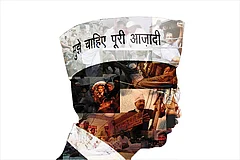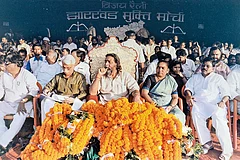Payal Kapadia’s unconventional documentary film, A Night of Knowing Nothing, clinched the prestigious L’Œil d’or (Best Documentary) award at the Cannes Film Festival in 2021. Just the next year, another acclaimed Indian documentary, Shaunak Sen’s All That Breathes, received the same honour. Yet, Kapadia’s film remains relatively obscure—less watched and less discussed. Perhaps its obscurity lies in its ability to strike a chord that we, consciously or not, choose to ignore. Maybe the film languishes in the shadows because it speaks to a fire within us that we’ve long neglected to ignite.
Kapadia’s A Night of Knowing Nothing delves into the events surrounding the strike at the Film and Television Institute of India (FTII) that took place during the monsoon of 2015. The discontent among students stemmed from the appointment of Gajendra Chauhan as the chairman, a position previously held by the esteemed filmmaker Ritwik Ghatak (to be more specific, Ghatak was the Vice Principal of FTII during the mid 60’s). Despite not explicitly mentioning Ghatak’s name, Kapadia’s film subtly portrays his enduring influence on the campus. At the outset of A Night of Knowing Nothing, during a tour of the campus, painted posters of Ghatak’s masterpiece Meghe Dhaka Tara (The Cloud-Capped Star) as well as that of his face stuck on the walls serve as poignant reminders of his legacy.

In Kapadia’s film, the strike, students’ agitation, and all the ensuing chaos are revealed through a collection of letters written by a female student, discovered in the cupboard of a hostel room at FTII. Alongside the letters lay several newspaper cuttings, dried flowers, and various other items that serve as echoes of her memory. These letters, written by the student known by the initial ‘L,’ are addressed to her estranged lover from the same institute. Through a female soliloquy, the letters shed light on the ongoing strike. In a moment of introspection, L questions her lover’s silence amidst the adversity on campus, stating, “It is getting harder to live on campus. Administration has been coming at us with more vengeance. I am feeling ashamed to admit it…but sometimes I think they are punishing us for going on strike…Like if we hadn’t gone on strike, would things be better now?” Amidst the campus protests, a single student is observed dancing within a ring of fire. Initially innocuous, the ring of fire transforms into a continuous circle, mirroring the flames ignited by the dissenters.
Chauhan’s appointment sparked an uproar as it was endorsed by the Bharatiya Janata Party (BJP)-led government. Students perceived it as a clear threat and insult to FTII’s history and tradition. Their resolute rallying cry, “Eisenstein, Pudovkin—We shall fight, we shall win”, echoed throughout the campus, garnering the government’s attention. Despite facing threats of expulsion, the students remained determined, ultimately leading to the arrest of five students during a midnight crackdown.
Kapadia’s camera captures everything, including the news that delves into the systemic discrimination prevalent within academic institutions, shedding light on instances of caste-based bias at Hyderabad Central University (HCU), and the unfounded stereotyping of Muslim students. It intertwines these narratives with significant national events, including the BJP’s electoral triumph, the killing of journalist Gauri Lankesh, and the heartrending suicide of Dalit student Rohith Vemula in January 2016.
As the narrative unfolds, L reflects on the dynamics of her relationship amidst the backdrop of societal upheaval, lamenting her lover’s passive stance on familial casteism. L says, “I thought that you would fight for us! I just don’t understand how you could stand beside me during the strike, shouting slogans of freedom against the government; but when it came to standing up to the casteism of your parents, you didn’t speak up.”
L’s monologue transports us to another Dussehra, a festival symbolising the triumph of good over evil celebrated nationwide. Yet, amidst the festivities, some of us grapple with the ambiguity of discerning between good and evil. Our individual consciousness often proves inadequate against the weight of collective memories spanning millennia, blurring the lines between truth and myth. This confluence of silence and chaos in the film serves as a poignant reflection of the complex interplay between sound and absence. L’s spoken words, resonant agitations, non-diegetic sounds, and moments of profound silence harmonise, illustrating the intricate relationship between sound and meaning within the narrative.
The students’ resolute rallying cry, “Eisenstein, Pudovkin—We shall fight, we shall win”, echoed throughout the Film and Television Institute of India (FTII) campus during the strike.
In the middle of the film, the agitation shifts from FTII to Delhi’s Jawaharlal Nehru University (JNU), where three student leaders were released from prison and returned to the University. The JNU protest against a 300 per cent fee hike is shown. L writes that the modes of protest were the same, only the bastions changed. Here we can see placards from parties such as AISA, AISF, SFI, CITU, and AIDSO. Interestingly, at this juncture, L’s voice-over transitions from Hindi to Bangla. Is it because of the protests across the country, our disillusionments, and every one of L’s parted love stories finding a language-agnostic zone? I don’t know. I don’t need to know as long as L keeps churning out my personal memories and guilt. I recall in 2012 when I was shooting my first feature film, one of my closest friends was incarcerated on charges of sedition. His crime? Going on a fact-finding assignment for a few displaced communities in the interiors of West Bengal. I couldn’t find the time to visit him in jail because I was busy with my hectic shooting schedule, editing, etc...Or perhaps they were all just excuses to cover up my fears and lack of empathy for my friend.
In the Delhi protest, observing senior leaders and professors marching alongside the students, L notices female police officers trailing behind. L contemplates a female police officer’s dual responsibilities at home and in the protest. This scenario evokes parallels to Italian filmmaker Pasolini’s support for the police during Italy’s 1968 student movement, where he remarked on the students being children of the bourgeoisie and the police as the proletariat. The question arises: can these students truly stir up a revolution without the support of the workers? Despite their opposing roles, L recognises their shared humanity, only separated by their uniforms.
A pertinent class question arises, complicating the blurry line between bourgeois student protesters advocating against fee hikes, ostensibly in favour of poorer students, and the police women hailing from humble economic backgrounds, who fulfil their roles by quelling the protests. As L empathises with the woman police officer, the impending reality of her eventual confrontation with L’s friends becomes palpable. Despite moments of empathy, when L witnesses the police initiating violence against the students, marking the onset of the ‘‘souvenir of violence”, she realises the officer’s allegiance lies with authority, further reinforcing the chasm between law enforcement and the protesters.
Abruptly, a nightmare jolts her awake, serving as a metaphor for the ruthless crackdown on dissenters depicted in the CCTV footage of the incident. In this moment, the raw emotion of a young woman is captured, perhaps marking the first instance where we meet L eye to eye as she stares directly into the camera. Tears fill her eyes, reflecting her personal anguish and the collective sorrow engulfing the nation. While grappling with the betrayal of her beloved, she finds herself confronted by a deeper sense of betrayal inflicted by the State. In her nightmare, she envisions a protest marred by brutality—a stark reflection of the harsh reality faced by many students. Forced to flee through a narrow window to evade the onslaught of the police, they find themselves engulfed by a torrent of water-cannons. As the scene unfolds, names of the friends fade into obscurity as individuals are swept away—First it was Prateek, then Nachi, and later Pravati vanishes, followed by Shaz, Himu, Neel, Devangana, Safoora, Natasha, Umar… one by one, they melt away into the water…leaving behind only the chilling echoes of their existence. L proclaims that she is scared. As the days pass, it becomes obvious that any ideology opposing theirs is not allowed to exist. In her final correspondence, L reminisces about her farewell from film school, marked by celebrations with friends amidst an uncertain future. Scribbled behind her note are the poignant words of the revolutionary poet Amir Aziz, “Everything will be remembered”, encapsulating the indomitable spirit of student movements everywhere.
In the end, a student ponders why the FTII movement gained such momentum. It’s not just about Chauhan, the Rashtriya Swayamsevak Sangh (RSS), or the students, but rather the era we’re living in. We may be residing in a time devoid of leaders to admire. Across the nation, encompassing various religions, castes, and creeds, there’s a collective yearning for leadership. The profound emptiness of our time propelled this uprising forward with such force.
I wonder how I can expect Kapadia’s film to gain popularity, even among the rebels of our time. In an era where the voices of dissenters are carefully kept disjointed, despite living in the age of social media where we are all forced to be interconnected, our conscious minds remain alienated due to a greater design by the powers that be. L’s fear seems to become reality. They will arrest all of us, one by one. A sincerely made political film of our time, A Night of Knowing Nothing deserves recognition, sharing, discussion, and debate. That’s the need of this era of nothingness.
(Views expressed are personal)
MORE FROM THIS ISSUE
Debarati Gupta is a Filmmaker, Columnist & Guest Lecturer at Calcutta University
This appeared in the print as Chronicling Dissent
































